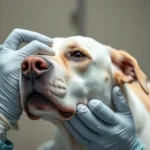
Introduction
Nail trimming is an essential part of dog care that often gets overlooked. Regular nail care not only enhances your dog’s comfort but also prevents painful injuries and behavioral issues. However, a common mishap among pet owners is cutting their dog’s nail too short, leading to bleeding. In this blog post, we’ll discuss what to do if you cut your dog’s nail too short and it’s bleeding, emphasizing the importance of prompt action to prevent complications and ensuring your furry friend remains healthy and happy.
Understanding Dog Nails
Anatomy of a Dog’s Nail
To better understand the situation, it’s important to know the anatomy of a dog’s nail. Each nail consists of three main parts: the quick, the nail, and the nail bed. The quick is the sensitive, pinkish area inside the nail that contains nerves and blood vessels. When you accidentally cut into the quick, it results in bleeding. Unlike human nails, which lack this sensitive area, dog nails require careful handling to avoid injury.
Why Regular Nail Trimming is Essential
Regular nail trimming is crucial for several reasons. Keeping your dog’s nails at an appropriate length helps maintain their overall health. Overgrown nails can lead to discomfort, pain, and even injuries, as they can catch on surfaces and break. Additionally, long nails may alter your dog’s gait, leading to joint problems and behavioral issues, such as reluctance to walk or play. Regular trimming promotes a healthy lifestyle and prevents complications.
What Happens When You Cut a Dog’s Nail Too Short
The Quick and Bleeding
When a dog’s nail is cut too short, it’s usually because the quick is accidentally clipped. The quick contains blood vessels and nerves, which is why cutting it results in bleeding. The bleeding can be alarming, but understanding what’s happening can help you remain calm and take appropriate action. Signs that a nail has been cut too short include immediate bleeding, your dog pulling their paw away, or signs of discomfort.
Immediate Reactions from the Dog
Dogs may exhibit a range of reactions when their nails are cut too short. Some common behaviors include whining, licking the affected paw, or withdrawing from interaction. It’s important to observe your dog’s emotional response, as they may be in pain or confused by the sudden discomfort.
Step-by-Step Guide: What to Do If You Cut Your Dog’s Nail Too Short and It’s Bleeding
Step 1: Stay Calm
The first step in handling this situation is to stay calm. Your dog can sense your anxiety, which may cause them to become more stressed. Take a deep breath and reassure your dog with a gentle voice.
Step 2: Assess the Situation
Next, assess the severity of the bleeding. Check if the quick is visible and how much bleeding is occurring. If the bleeding appears to be minimal, you may be able to manage it at home. However, if it is excessive or persistent, you may need to seek veterinary assistance.
Step 3: Apply Pressure
To stop the bleeding, apply gentle pressure to the nail. You can use a clean cloth or gauze to wrap around the affected area. Hold the pressure for a couple of minutes; this often helps to clot the blood and reduce the bleeding.
Step 4: Use Styptic Powder or Cornstarch
If the bleeding continues, consider using styptic powder—a product designed to stop bleeding quickly. To apply it effectively, simply sprinkle a small amount directly onto the bleeding nail and apply pressure. If you don’t have styptic powder, alternatives like cornstarch or flour can work as well. Just ensure to use enough to cover the area.
Step 5: Clean the Area
Once the bleeding has stopped, it’s important to clean the area around the nail. Use a mild antiseptic solution or warm water to gently clean the nail and surrounding area to prevent infection. Avoid using alcohol or hydrogen peroxide, as they can be too harsh and irritating.
Step 6: Monitor the Dog
After addressing the immediate issue, monitor your dog for any unusual signs. Look for excessive bleeding continuing beyond 10-15 minutes, swelling, redness, or discharge from the nail area. If you notice any of these signs, consult your veterinarian promptly.
Preventative Measures for Future Nail Trimming
Choosing the Right Tools
Using the right tools is critical in preventing nail cutting mishaps. Invest in high-quality nail clippers specifically designed for dogs. Choose sharp, appropriate-sized tools that can easily cut through your dog’s nails without causing splintering or excessive pressure.
Techniques for Safe Nail Trimming
To avoid cutting nails too short in the future, familiarize your dog with the nail trimming process. Start by letting them sniff the clippers and giving them treats when they remain calm. When trimming, cut in small increments, taking your time to examine the nail’s structure. This technique minimizes the risk of hitting the quick.
Regular Nail Care Routine
Establishing a regular nail trimming schedule is vital. Depending on your dog’s activity level and growth rate, you may need to trim their nails every 3-6 weeks. Introducing your dog to nail care from an early age helps them become accustomed to the process, making it easier and less stressful for both of you.
When to Seek Veterinary Care
Signs That Require Professional Help
While many nail trimming accidents can be managed at home, there are situations that warrant a visit to the vet. If the bleeding does not stop after 10-15 minutes, or if you notice signs of infection such as swelling, redness, or discharge, seek professional help. Additionally, if your dog appears to be in severe pain or is significantly limping, it’s time to consult a veterinarian.
Preparing for the Vet Visit
If you decide to take your dog to the vet, be prepared with relevant information. Explain what happened, how long the bleeding lasted, and any symptoms your dog has shown. This information will help the veterinarian determine the best course of action. Additionally, consider ways to manage your dog’s anxiety during the visit, such as bringing their favorite toy or blanket.
Conclusion
In conclusion, knowing what to do if you cut your dog’s nail too short and it’s bleeding is crucial for maintaining your dog’s health and wellbeing. Regular nail care is an integral part of responsible pet ownership, and being prepared for nail trimming mishaps can make a significant difference in your dog’s comfort and safety. Always remember to practice safe nail trimming techniques, monitor your dog’s health, and consult your veterinarian when needed. Your dog’s health is worth the effort!
By following these guidelines, you can ensure that your furry friend continues to enjoy a happy, active life free from the pain and discomfort of overgrown or improperly trimmed nails.









